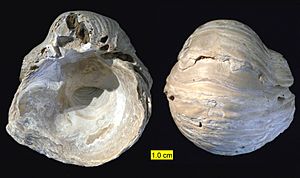Gryphaea facts for kids
Quick facts for kids Gryphaea |
|
|---|---|
 |
|
| Gryphaea sp. from the Cretaceous of Texas; left valve interior and exterior (same specimen) | |
| Scientific classification |
|
| Kingdom: | Animalia |
| Phylum: | Mollusca |
| Class: | Bivalvia |
| Order: | Ostreida |
| Family: | Gryphaeidae |
| Genus: | †Gryphaea Lamarck, 1801 |
Gryphaea (the Devil's toenail) is a genus of extinct oysters which were once very common. Their fossils are common on the Jurassic Coast in southern England, and in the margins of the old Sundance Sea in the United States. It is a marine bivalve mollusc in the family Gryphaeidae.
These bivalves were at their peak in the Jurassic and Cretaceous periods, when they sat in huge muddy oyster beds in shallow tropical seas. The genus survived a long time, but went extinct about 34 million years ago (mya).
The oyster shell has two 'valves': a larger gnarly-shaped shell (the 'toenail') and a smaller, flattened shell, the 'lid'. The soft parts of the animal lived in the gap between the two shells, just like modern oysters. The shells have prominent growth bands. The large curved shell sat in the mud on the sea floor.
Where to find it
In England at the coasts of Redcar and Weymouth in the Kimmeridgian clay; in the U.S.A in riverbanks and cliffs of Texas and Kansas. They are often washed out of the clay onto the beach or river banksides.
See also
 In Spanish: Gryphaea para niños
In Spanish: Gryphaea para niños

